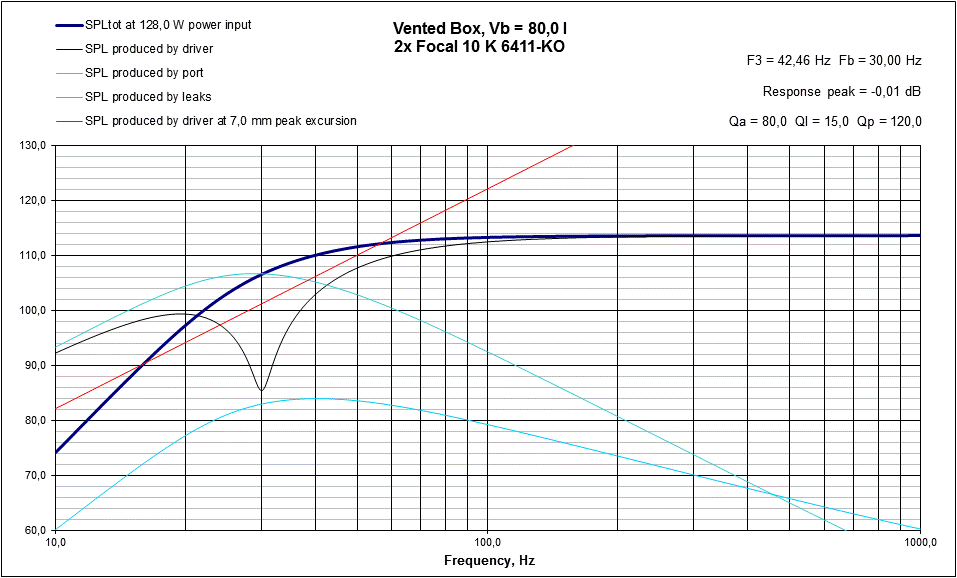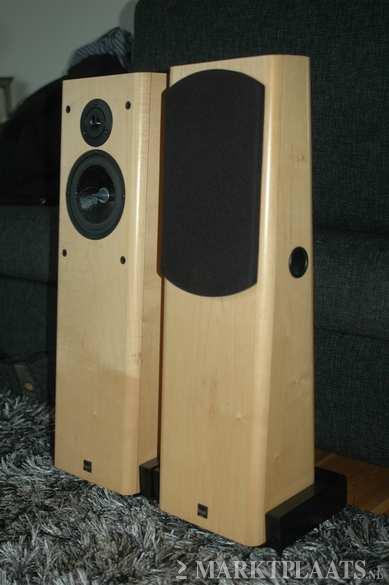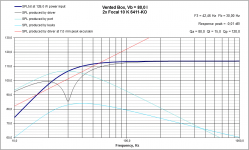I am in the startup phase for a new speaker project and I can't make up my mind on where to place the port. Always good to run these kind of things past the experienced folk 🙂
So here are my three options:
The circle with the "T" inside is the tweeter, the port is the hole with all the concentric circles (just to clarify 😀)
- Option 1 has the port on the backside. Problem is that one of the speakers will not have wall behind it, so there will be barely any reflection coming from it. I will be very flexible in where to place the drivers vertically, but besides that, I guess this is not the best option.
- Option 2 has the port at the bottom, nothing wrong with this I guess, except that the tweeter has to be about 20cm above ear level when sitting. I don't think this should be a major issue when looking at the vertical dispersion plots of the tweeter though.
- Option 3 has the port all the way at the top. Looks maybe a bit odd and since it will bend downward inside the speaker, my kids will be able to throw toys and candy in which will then be difficult to retrieve 😛. Good thing is that I can move the entire driver combination downward so that the tweeter is exactly at ear level.
Any comments / suggestions / ideas on the above?
So here are my three options:
An externally hosted image should be here but it was not working when we last tested it.
The circle with the "T" inside is the tweeter, the port is the hole with all the concentric circles (just to clarify 😀)
- Option 1 has the port on the backside. Problem is that one of the speakers will not have wall behind it, so there will be barely any reflection coming from it. I will be very flexible in where to place the drivers vertically, but besides that, I guess this is not the best option.
- Option 2 has the port at the bottom, nothing wrong with this I guess, except that the tweeter has to be about 20cm above ear level when sitting. I don't think this should be a major issue when looking at the vertical dispersion plots of the tweeter though.
- Option 3 has the port all the way at the top. Looks maybe a bit odd and since it will bend downward inside the speaker, my kids will be able to throw toys and candy in which will then be difficult to retrieve 😛. Good thing is that I can move the entire driver combination downward so that the tweeter is exactly at ear level.
Any comments / suggestions / ideas on the above?
Have you considered putting the port on the bottom facing the floor? Great option to take kids and toys out of the equation as well as gives you a way to make it one long straight pipe and possibly larger diameter/length.
Keeping the port(s) low on the front baffle typically provides the best and most versitile room integration.
Oval ports: two or three along the bottom. Several sources for oval plastic ports + tube.
Slot port: wood plank along the full bottom baffle width. You can use a router for edge round over to smooth air flow. Popular with European designs and large woofers.
Oval ports: two or three along the bottom. Several sources for oval plastic ports + tube.
Slot port: wood plank along the full bottom baffle width. You can use a router for edge round over to smooth air flow. Popular with European designs and large woofers.
Not sure about down firing. The port will be about 110mm and I only have 40mm of play between the floor and bottom of the speaker. I think this will affect airflow in a negative way.Have you considered putting the port on the bottom facing the floor? Great option to take kids and toys out of the equation as well as gives you a way to make it one long straight pipe and possibly larger diameter/length.
Sent from my SGP612 using Tapatalk
I have been thinking about slot ports, difficult to integrate in my design though, since the box shape will be concave towards the back so the shape of the slot has to change when I bend it upwards. A round port would be by far the easiest.Keeping the port(s) low on the front baffle typically provides the best and most versitile room integration.
Oval ports: two or three along the bottom. Several sources for oval plastic ports + tube.
Slot port: wood plank along the full bottom baffle width. You can use a router for edge round over to smooth air flow. Popular with European designs and large woofers.
Total port length with 110mm (~4,5") diameter would be about 800mm (32"), so I have to work with one bend to make it fit...
The 1/4 Wave rule is the standard and it makes no difference where the port is, front, side, rear, top or bottom. Even a horn shape on the outside of the cabinet is acceptable but not always wanted by the lady of the house.
https://www.trueaudio.com/st_ventq.htm
https://www.trueaudio.com/st_ventq.htm
Never seen a port so long. You have either a too low box volume, or too low tuning (or both).Total port length with 110mm (~4,5") diameter would be about 800mm (32"), so I have to work with one bend to make it fit...
In any case, it seems you have the wrong idea on how a tube works. It doesn't need a reflection wall or floor, as the low frequencies are omnidirectional. When you place a speaker with a back firing tube near to a wall what you are doing is to double the bass amount, with some drawbacks. It puzzles me that the speaker placement is not specular, as the bass volume will be different (not only the tube frequencies, but also the frequencies coming from drivers).
Ralf
Never seen a port so long. You have either a too low box volume, or too low tuning (or both).
In any case, it seems you have the wrong idea on how a tube works. It doesn't need a reflection wall or floor, as the low frequencies are omnidirectional. When you place a speaker with a back firing tube near to a wall what you are doing is to double the bass amount, with some drawbacks. It puzzles me that the speaker placement is not specular, as the bass volume will be different (not only the tube frequencies, but also the frequencies coming from drivers).
Ralf
About the port being so long, it's indeed a low box volume (still 80L though...) and a very low tuning of 22Hz. If I make the box volume larger (so decreasing the port length) I will run into excursion issues with the woofers. If I make the diameter of the port smaller I will run into port noise issues... Not sure if there are any sound quality drawbacks with a long port?
Aren't there plenty of slot-ported speakers with a port length of well over 1m?
Name a few.
Ralf
What are the drivers, and have you simulated the outcome with unibox?
This one for example, but it is indeed more difficult to find than I initially thought 🙂.
I have simulated everything in Bassbox Pro 6. I guess I would get the same outcome in Unibox.
But about port length, this is an interesting thing you bring up which I haven't thought about. After doing some quick research online I can't find anything really against long ports besides that the port resonance can become an issue. 30"-40" max is what I can find, but nothing to really back that up...
There is no problem by itself with long port, except that you will want to lower the xover frequency to the point where standing waves in the port are not limiting performance. Since an open pipe will sustain wave lengths of 1/2 times an integer number, for a 1 meter vent, a practical cut off frequency would be 85 Hz. The reason is that you want to stay away about one octave from the lowest frequency that can be sustained by the vent, which is about 170Hz for 1 meter.
Version 2 of your drawings is best when it comes to maximizing bass output....but not @ 20 hZ.
I cannot find information on the TD10S, only the TD10M. If the S-version is largely similar, it is not fit to be used under let's say 40-50Hz. Like most 10 inch woofers, by the way. 20Hz is too low for any 10 inch woofer being presently produced afaik. Apart from a speaker of this size not being able to produce much output @ 20Hz to begin with, this is compounded by the fact that at such low frequencies, the ear is very insensitive; you need very high SPL to discern any sound at 20 Hz. Only big speakers can go there.
In short, from what I can tell, change your plan and aim for a higher Fb.
Version 2 of your drawings is best when it comes to maximizing bass output....but not @ 20 hZ.
I cannot find information on the TD10S, only the TD10M. If the S-version is largely similar, it is not fit to be used under let's say 40-50Hz. Like most 10 inch woofers, by the way. 20Hz is too low for any 10 inch woofer being presently produced afaik. Apart from a speaker of this size not being able to produce much output @ 20Hz to begin with, this is compounded by the fact that at such low frequencies, the ear is very insensitive; you need very high SPL to discern any sound at 20 Hz. Only big speakers can go there.
In short, from what I can tell, change your plan and aim for a higher Fb.
Last edited:
There is no problem by itself with long port, except that you will want to lower the xover frequency to the point where standing waves in the port are not limiting performance. Since an open pipe will sustain wave lengths of 1/2 times an integer number, for a 1 meter vent, a practical cut off frequency would be 85 Hz. The reason is that you want to stay away about one octave from the lowest frequency that can be sustained by the vent, which is about 170Hz for 1 meter.
Version 2 of your drawings is best when it comes to maximizing bass output....but not @ 20 hZ.
I cannot find information on the TD10S, only the TD10M. If the S-version is largely similar, it is not fit to be used under let's say 40-50Hz. Like most 10 inch woofers, by the way. 20Hz is too low for any 10 inch woofer being presently produced afaik. Apart from a speaker of this size not being able to produce much output @ 20Hz to begin with, this is compounded by the fact that at such low frequencies, the ear is very insensitive; you need very high SPL to discern any sound at 20 Hz. Only big speakers can go there.
In short, from what I can tell, change your plan and aim for a higher Fb.
Link to the S parameters. It is designed to go lower than the M, but maybe I'm pushing it a bit in the 20Hz section indeed. I do want to have them flat all the way down to 30Hz though, which seems doable when modelling the drivers.
That is an easy speaker to get right without calculations. At this Qts, Fb=Fs=32.7 Hz, Vb=Vas x number of drivers. Will be good.
I have simulated 2x AE TD10S wired in parallel with unibox. A 80L box tuned to 30Hz needs a 10 cm diameter x 25 cm long tube. In my experience the length will be something lower, and 20 to 25 cm is manageable. A textbook tuning for your driver would be greater than 35Hz, a better room integration would be with a lower tuning, and in this respect 30Hz gives a good response with a F6 at 32Hz (compared to a F6 of 38Hz for a 22Hz tuning).
With a 30Hz tuning the drivers will be excursion limited at 24Hz for a maximum power of 128W giving almost 114dB, with port air speed always under 7.5% of sound speed. I don't see any point in going with a lower tuning.
Ralf

With a 30Hz tuning the drivers will be excursion limited at 24Hz for a maximum power of 128W giving almost 114dB, with port air speed always under 7.5% of sound speed. I don't see any point in going with a lower tuning.
Ralf
Attachments
You should familiarize yourself with drivers from SEAS, Scanspeak, Morel, etc...I cannot find information on the TD10S, only the TD10M. If the S-version is largely similar, it is not fit to be used under let's say 40-50Hz. Like most 10 inch woofers, by the way. 20Hz is too low for any 10 inch woofer being presently produced afaik. Apart from a speaker of this size not being able to produce much output @ 20Hz to begin with, this is compounded by the fact that at such low frequencies, the ear is very insensitive; you need very high SPL to discern any sound at 20 Hz. Only big speakers can go there.
.
Face, which one can produce 20Hz at a level discernible to humans? Two of the manufacturers you name make some fine drivers, but none that can do this.
I have simulated 2x AE TD10S wired in parallel with unibox. A 80L box tuned to 30Hz needs a 10 cm diameter x 25 cm long tube. In my experience the length will be something lower, and 20 to 25 cm is manageable. A textbook tuning for your driver would be greater than 35Hz, a better room integration would be with a lower tuning, and in this respect 30Hz gives a good response with a F6 at 32Hz (compared to a F6 of 38Hz for a 22Hz tuning).
With a 30Hz tuning the drivers will be excursion limited at 24Hz for a maximum power of 128W giving almost 114dB, with port air speed always under 7.5% of sound speed. I don't see any point in going with a lower tuning.
Ralf

I forgot to mention that I model using an active HP filter setup in Bassbox pro. If I would go for a normal vented solution I get the same results as you:
An externally hosted image should be here but it was not working when we last tested it.
Dark Blue = Normal vented (same as Giralfino's)
Light Blue = Same box size but with an active HP filter of 30Hz
Red = My current best model for reaching lowest possible F3 while staying within the drivers max values
Vent velocities at 500W for the same setups:
An externally hosted image should be here but it was not working when we last tested it.
As you can see the vent velocities for the dark blue one (Giralfino's) and the red one are about the same, and will be more reasonable around 128W, but the light blue one goes a bit banana's.
For info: I will be using active correction on these woofers to flatten the response out to get an F3 of let's say 25-30Hz (as low as reasonably possible), so I will be loosing some SPL. This will be made up for by the high sensitivity of the woofers.
An alternative solution would be to go sealed and use active correction to correct to get a flat response to 30Hz. I would loose about 8dB at 30Hz compared to the red curve and about 3dB compared to the dark blue curve.
Hmmm... saves a lot of hassle and I never have to retrieve any toys from the port... 🙂
- Status
- Not open for further replies.
- Home
- Loudspeakers
- Multi-Way
- Port / driver placement

